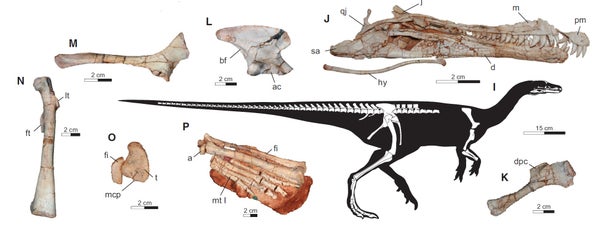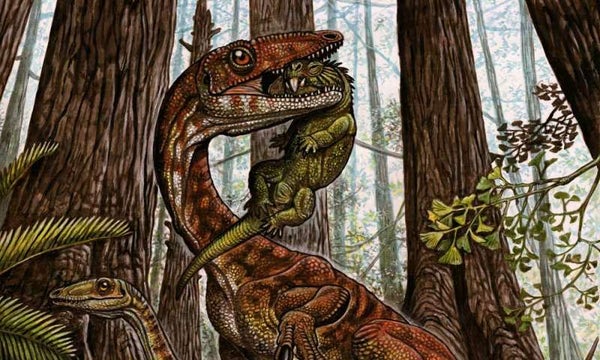This article was published in Scientific American’s former blog network and reflects the views of the author, not necessarily those of Scientific American
The great sauropod dinosaurs, like Apatosaurus, are often referred to as gentle giants. Whether they deserve this title or not is unknown. After all, herbivores can often be more dangerous than carnivores - a bison is much more of a threat to human life and limb than a wolf. It's that vegetarian diet that softens our impression. Feeding a titanosaur a bushel of ferns is cute while offering a meal to an Allosaurus would be a bloody spectacle. If this is the case, though, sauropods are not able to claim an entirely clean record. As paleontologists have dug further and further into their past, it's become clear that these dinosaurs changed their diet over time. The very first members of the sauropod line ate meat.
Multiple discoveries made in South America have led paleontologists to realize that the very first dinosaurs were likely carnivores or omnivores. A new find in Brazil underscores the point. This early dinosaur, named Buriolestes by Sergio Cabreira and colleagues, was found in the 237-228 million year old rock of the Paraná Basin. It was a slender saurian that ran around on two legs and had a mouth full of sharp teeth, yet the anatomical details of the skeleton indicate that Buriolestes was a sauropodomorph - an early member of the group that would later contain gawky weirdos like Plateosaurus and towering, herbivorous giants such as Brachiosaurus.
Exactly what Buriolestes ate is unclear. That's something fossil feces, gut contents, and other lines of evidence will hopefully clear up if they are ever discovery. But the recurved, serrated teeth of Buriolestes leave little doubt that this early relative of Diplodocus was eating other animals, possibly including the little protodinosaur Ixalerpeton that lived in the same place (and was named in the same paper). The discovery of Buriolestes, Cabreira and coauthors write, "confirms that early members of the otherwise typically herbivorous Sauropodomorpha were likely predators," making the backstory of placid, plodding giants a bit bloodier.

Selected bones and reconstruction of Buriolestes. Credit: Cabreira et al. 2016
Fossil Facts
On supporting science journalism
If you're enjoying this article, consider supporting our award-winning journalism by subscribing. By purchasing a subscription you are helping to ensure the future of impactful stories about the discoveries and ideas shaping our world today.
Name: Buriolestes schultzi
Meaning: Buriolestes combines the family name of the landowners where the fossils were found with the Greek word for robber. The species name schultzi is after paleontologist Cesar Schultz.
Age: Triassic, 237-228 million years ago.
Where in the world?: Paraná Basin, Brazil.
What sort of critter?: An early sauropodomorph dinosaur.
Size: About five feet long.
How much of the creature’s body is known?: Part of the skull, much of an arm and shoulder, a leg, the hips, and vertebrae from the middle of the back to the tail.
Reference:
Cabreira, S., Kellner, A., Dias-da-Silva, S., da Silva, L., Bronzati, M., de Almedia Marsola, J., Müller, R., de Souza Bittencourt, J., Batista, B., Raugust, T., Carrilho, R., Brodt, A., Langer, M. 2016. A unique Late Triassic dinosauromorph assemblage reveals dinosaur ancestral anatomy and diet. Current Biology. doi: 10.1016/j.cub.2016.09.040
Previous Paleo Profiles:
The Light-Footed Lizard The Maoming Cat Knight’s Egyptian Bat The La Luna Snake The Rio do Rasto Tooth Bob Weir's Otter Egypt's Canine Beast The Vastan Mine Tapir Pangu's Wing The Dawn Megamouth The Genga Lizard The Micro Lion The Mystery Titanosaur The Echo Hunter The Lo Hueco Titan The Three-Branched Cicada The Monster of Minden The Pig-Footed Bandicoot Hayden's Rattlesnake Demon The Evasive Ostrich Seer The Paradoxical Mega Shark The Tiny Beardogs The Armored Fish King North America's Pangolin The Invisible-Tusked Elephant The Mud Dragon The Spike-Toothed Salmon The Dream Coast Crocodile
